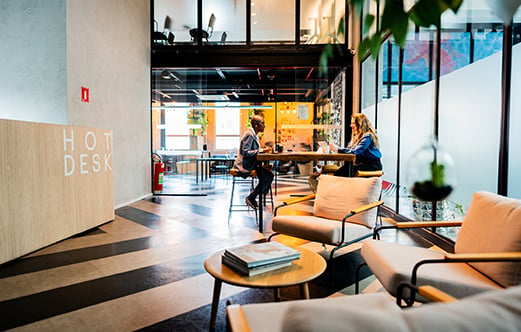Emerging Trends and Technologies to Reshape the Built Environment

This fall, NAIOP Research Foundation Governors, Visionaries and Distinguished Fellows met in Toronto to discuss trends affecting the commercial real estate industry and suggest possible topics for future research. The meeting opened with a presentation by Greg Lindsay, non-resident senior fellow of MIT’s Future Urban Collectives Lab, Arizona State University’s Threatcasting Lab, and the Atlantic Council’s GeoStrategy Initiative.
Greg Lindsay’s Presentation: The Way We’ll Live Next
Lindsay presented a series of emerging trends and technologies that have the potential to reshape the economy, society and the built environment.
Lindsay observed that the period since the COVID-19 pandemic has seen an acceleration of migration toward the sunbelt, toward smaller cities, and toward increasing sprawl. At the same time, younger Americans have experienced growing social isolation, with fewer young people living together, fewer hours spent socializing on weekends, and more time spent at home alone and with television, video games, and (most recently) generative AI. The recent advances in generative AI also have made it harder for recent graduates to find jobs, with declining employment of young people in fields like customer service and software development. The information technology sector has been particularly impacted, with large firms like Microsoft reducing their headcounts and Amazon hiring fewer white-collar workers.
As Lindsay catalogued AI’s emerging capabilities, it became easier to understand why employers have recently been slow to hire less experienced workers. In addition to the potential to expand the productivity of current workers, Lindsay mapped out how researchers expect that AI “agents” can be trained to simulate the work of specific individuals and are expected to gradually take over more tasks as companies adopt them. Examples include joining Zoom meetings as avatars for individual workers or meeting with other AI agents to exchange information. In theory, an entire billion-dollar firm could be set up with AI agents filling most of its functional roles, answering to a single human manager.
Recent technological developments have also had a clear impact on commercial real estate. Remote and hybrid work arrangements continue, with the “return to office” largely complete and office utilization significantly below pre-pandemic levels. Development of new office buildings, as well as most other CRE asset classes, has slowed dramatically, with new construction concentrated in data centers. Capital expenditure on AI is now larger than consumer spending and is contributing to a surge in demand for new electrical power generation. Meanwhile, continued advances in augmented reality, like Meta’s smart glasses, raise new questions for commercial property owners about how people interact with the built environment. Who controls the digital representation of real properties? What advertisements are being virtually projected onto a building? Will pedestrians notice a coffee shop if the map application in their glasses directs them to a promoted competitor around the corner?
Autonomous vehicles and robots continue to advance, with the potential to significantly reduce the costs associated with transporting goods and people. Waymo and Uber have moved from developing autonomous vehicles to gradually deploying robotaxis market by market. Autonomous truck routes, such as those being tested by Aurora in Texas, could reduce short and long-haul trucking costs. Smaller-scale automation is having a similar effect, with robots such as those operated by Starship and drones, like those operated by Zipline, delivering food and small packages. Why deliver a burrito in a car, when a small robot or drone can make the same delivery at a lower cost?
At the conclusion of his presentation and in response to questions from the audience, Lindsay emphasized that the impact of AI and other emerging technologies on our economy and the built environment will depend on how society chooses to adapt. AI’s long-term impact on white-collar employment will depend on whether employees are replaced by AI agents or become “centaurs” that use AI to enhance their productivity.
He outlined three possible trends for future community development and the built environment. If people increasingly spend their time indoors, interfacing with screens, generative AI, and augmented or virtual reality, it would support the development of more sprawling, less integrated communities. Another possibility is that housing costs, rising medical costs, and longer lifespans could prompt more intergenerational living and infill suburban development as a larger share of seniors choose to invite younger family members to live with them rather than move to senior living centers. The third possibility, and Lindsay’s preference, would be for communities to use new technologies to enable more walkable urban environments.
Breakout Discussions on Trends in CRE
Attendees broke into groups at their respective tables to discuss emerging trends and potential topics to consider for future research. How society, the economy, and the CRE industry would adapt to AI was a common theme between the different groups. Several groups discussed questions related to how AI will affect the supply and demand for different skillsets:
How employers will be looking more to AI for some technical skills and how that might affect the types of skills that higher education programs emphasize and whether students pursue master’s degrees or other credentials;
That AI may change the relative value placed on different skillsets and that trade schools may lead to more AI-resilient careers;
And that AI appears to be making it harder for younger workers to break into careers.
Others raised questions about applications for AI in commercial real estate, such as to support feasibility evaluation for more complex projects, or to analyze a building, its location, and recent lease data to identify top potential tenants and how to market the building to them. More than one group indicated that the Research Foundation should frequently revisit the topic of AI to see how it is affecting demand for and the development of different commercial property types, not just data centers.
In addition to AI-related topics, attendees also discussed a range of other issues, such as the challenge that NIMBYism presents for future development, how new/younger recruits tend to lack key soft skills, the potential for new automation technologies to lower construction costs, and whether future electrical power generation will be adequate to meet booming demand.

